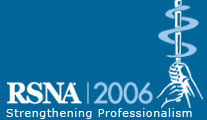
Abstract Archives of the RSNA, 2006
SSQ05-04
Human Pulmonary Gas Exchange with Hyperpolarized 129Xe
Scientific Papers
Presented on November 30, 2006
Presented as part of SSQ05: Chest (MR Imaging)
Samuel Patz PhD, Presenter: Nothing to Disclose
Iga Muradyan MS, Abstract Co-Author: Nothing to Disclose
Mirko I. Hrovat PhD, Abstract Co-Author: Nothing to Disclose
James P. Butler PhD, Abstract Co-Author: Nothing to Disclose
George Topulos MD, Abstract Co-Author: Nothing to Disclose
F. William Hersman PhD, Abstract Co-Author: CEO, Xemed LLC
Massimo Ferrigno MD, Abstract Co-Author: Nothing to Disclose
Francine L. Jacobson MD, MPH, Abstract Co-Author: Nothing to Disclose
et al, Abstract Co-Author: Nothing to Disclose
To develop human pulmonary gas exchange methods and to measure the dependence of gas exchange on lung volume (VL) and exchange time (texch).
A Univ. of New Hampshire 129Xe polarizer, which produces ~1L/hr of 40% polarized gas was located at Brigham and Women's Hospital near a 0.2T GE Profile magnet. A broadband Tecmag spectrometer was interfaced to the system. Two methods were used to measure gas exchange: (1) a saturation recovery method we previously developed (Butler et al, J Phys Cond Matt 12(2002), L297-304) and (2) a modified version of the Xenon Transfer Contrast (XTC) method of Ruppert et al (MRM 51:676-687,2004). Human studies with healthy adults were performed under both IRB and FDA IND approval. With method 1, whole lung measurements of gas exchange vs VL at constant texch and gas exchange vs texch at constant VL were performed. The modified version of XTC required a single 13s breath-hold and produced ventilation and gas exchange maps. XTC images were obtained at two different VL's, functional residual capacity (FRC) and at a volume 3L above residual volume (RV), which is close to total lung capacity (TLC).
Over a 7-month period, 200 breath-hold experiments were performed on 12 subjects. For texch<~80ms, the dissolved state signal increases diffusively, i.e. as sqrt(texch). Using an analytical relationship (Butler et al) relating the measured ratio of dissolved to gas signals to the alveolar surface area per unit VL (Sa/VL), Sa/VL was obtained as a function of VL. Fits of the data to 1/VL show a linear dependence of Sa/VL to 1/VL indicating Sa is constant with VL. This is different from literature values obtained in animal lungs fixed by vascular perfusion. XTC images at FRC show a decrease in gas exchange by a factor of ~2 from lung base to apex whereas XTC images at 3L above RV show a much smaller gradient as well as lower overall gas exchange, which is consistent with the fact that Sa/VL is lower at higher VL.
MRI methods to image and quantitatively measure local human pulmonary Sa/VL are demonstrated.
Noninvasive human gas exchange imaging could have a dramatic impact on the ability to detect early emphysema.
Patz, S,
Muradyan, I,
Hrovat, M,
Butler, J,
Topulos, G,
Hersman, F,
Ferrigno, M,
Jacobson, F,
et al, ,
Human Pulmonary Gas Exchange with Hyperpolarized 129Xe. Radiological Society of North America 2006 Scientific Assembly and Annual Meeting, November 26 - December 1, 2006 ,Chicago IL.
http://archive.rsna.org/2006/4429869.html

